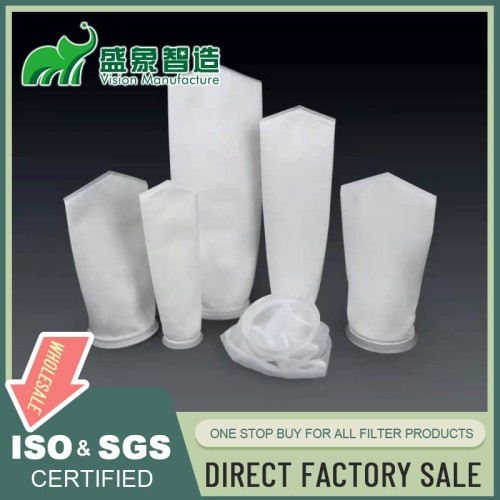
90 Micron Filter Bags Optimize Industrial Filtration Processes
I. Introduction
In the diverse landscape of industrial filtration, the role of intermediate micron ratings like 90 microns is crucial for optimizing processes across various industries. This introduction explores the significance of 90 micron filter bags, highlighting their importance in enhancing operational efficiency and process optimization.
II. Understanding 90 Micron Filtration
90 micron filtration serves as a critical step in removing moderate to fine particulates from fluids:
- Micron Rating Explained: Explains the scale and scope of what 90 micron filters capture.
- Particle Size Perspective: Discusses the specific types of particles targeted by this level of filtration.
- Filtration Efficiency at This Level: Evaluates how effectively these filters remove contaminants from fluids or gases.
III. Types of 90 Micron Filter Bags
These filter bags come in various materials and constructions to suit different industrial needs:
- Material Options: Includes polypropylene, polyester, and nylon, each offering unique benefits.
- Construction Methods: Features sewn, welded, and mesh options to enhance durability and performance.
- Size and Shape Variations: Available in multiple configurations to fit a wide range of systems.
IV. Industrial Applications
90 micron filter bags are essential across multiple sectors:
- Water and Wastewater Treatment: Crucial for removing particulates from water.
- Chemical Processing: Filters out impurities that could compromise chemical reactions.
- Food and Beverage Production: Ensures the purity and safety of food products.
- Pharmaceutical Manufacturing: Used in the filtration of liquids to ensure product purity.
- Automotive Fluids Filtration: Essential for maintaining the purity of automotive operational fluids.
- Paint and Coatings Industry: Captures particulates to ensure high-quality paint finishes.
V. Key Features and Benefits
The benefits of using 90 micron filter bags include:
- Balanced Filtration Efficiency: Effectively removes a wide range of particle sizes.
- High Flow Rates: Allows for the efficient processing of large volumes of fluid.
- Good Dirt-Holding Capacity: Can accumulate substantial amounts of particulate matter before requiring cleaning or replacement.
- Versatility in Applications: Suitable for a wide range of applications due to their robust design.
- Cost-effectiveness: Offers a good balance between performance and expense.
VI. Material Selection Criteria
Choosing the right material for 90 micron filter bags involves understanding:
- Chemical Compatibility: Ensuring the material is suitable for the specific chemicals in the process.
- Temperature Resistance: Choosing materials that can withstand the operational temperature range.
- Abrasion Resistance: Ensuring the bags can handle the physical demands of the application.
- Durability and Lifespan: Selecting materials that offer long service life under typical operating conditions.
VII. Design Considerations
The design of 90 micron bags is critical for their performance:
- Bag Dimensions and Capacity: Tailored to meet the requirements of various filtration systems.
- Seam Types and Strength: Affects the overall strength and integrity of the bags.
- Surface Treatments: Often includes treatments like singeing or coating to improve performance.
- Attachment Methods: Ensures secure and effective integration into existing systems.
VIII. Performance Characteristics
Performance metrics for 90 micron bags include:
- Flow Rate Capabilities: The volume of fluid that can be processed efficiently.
- Pressure Drop Profiles: Minimizing resistance to maintain energy efficiency.
- Particle Retention Efficiency: Effectiveness in trapping desired particle sizes.
- Service Life Expectations: Duration the bags can be expected to perform before needing replacement.
IX. Installation and Maintenance
Proper installation and regular maintenance are crucial for the performance of 90 micron filter bags:
- Proper Installation Techniques: Ensures the integrity of the bags during setup.
- Break-in Procedures: Important for stabilizing the filter's performance after installation.
- Cleaning and Regeneration Methods: Techniques to maintain filter efficiency.
- Replacement Guidelines: Knowing when to replace bags to maintain system efficiency.
X. Comparative Analysis
Comparing 90 micron filtration to other filtration methods highlights its advantages:
- 90 Micron vs. Finer Filtration Grades: Evaluating the need for subsequent finer filtration stages based on the application.
- Advantages Over Coarser Filters: Assessing the benefits of more precise particle removal compared to larger micron ratings.
- Cost-Benefit Analysis in Various Applications: Evaluating the economic impacts of using 90 micron bags versus other filtration methods.
XI. Environmental Considerations
Using 90 micron bags has a positive environmental impact by:
- Recyclability of Filter Materials: Encourages the use of sustainable practices.
- Energy Efficiency in Filtration Processes: Reduces the overall energy consumption of the system.
- Waste Reduction Through Reusability: Minimizes environmental footprint.
- Eco-friendly Disposal Methods: Encourages responsible end-of-life handling.
XII. Case Studies
Illustrative examples from various industries demonstrate the benefits of implementing advanced dust collector systems, highlighting improvements in air quality, efficiency in material handling, and compliance with environmental standards.
XIII. Future Developments
Emerging technologies and trends in the field of filtration include:
- Advanced Materials for 90 Micron Filtration: Enhancements that improve durability and filtration efficiency.
- Smart Filtration Systems Integration: Incorporation of sensors and monitoring systems for better management.
- Customization for Specific Industry Needs: Tailoring solutions to meet specific industrial needs.
- Improvements in Manufacturing Techniques: Enhancing the production process to increase filter effectiveness and reduce costs.
XIV. Conclusion
90 micron filter bags are essential for optimizing industrial filtration processes, offering a balance of efficiency and cost-effectiveness. As industries continue to demand higher standards in filtration, these bags provide a reliable and effective solution. For organizations looking to enhance their filtration systems, embracing these advanced solutions is a strategic move towards achieving superior operational outcomes.
Leave a comment

